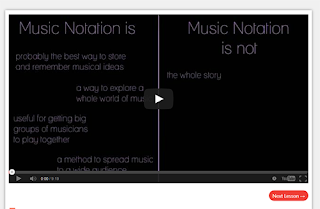One benefit of distance education is that it allows greater
access to non-traditional students who may not have been able to otherwise
acquire the knowledge and skills they need via traditional methods of
physically attending a brick and mortar institution. The growing number of online
open courses, courses which any one may attend once he or she has access to the
necessary equipment, has provided even greater opportunities for learners to
benefit.
 |
| Well designed section graphics |
Although online open courses are well intentioned, the
quality and effectiveness of the courses vary. For example, one site, Dave Conservatoire, proclaims that
it aims to provide free world-class music education for all. The site offers a
beginner course in reading
music notation. Noting that visual
information is important to distance learners because it helps to break down
complex information, Simonson, Smaldino, Albright and Zvacek (2012) recommend
large, sans-serif fonts, white space, minimal text for each graphic and using a
combination of upper and lower case letters. On first entry Dave Conservatoire
appears to be well designed. The introductory staff and clef
page is very appealing and has the subsections clearly identified for the
distance learners using clear graphic elements.
 |
| Poor colour contrast negatively affects visibility |
Unfortunately, many learners may not get to the beautiful
pages because the introductory
video features purple writing on a black screen, definitely a design snafu.
Poor visuals are ineffective in any learning situation but particularly so in a
distance education setting where the online learner may not have immediate
communication means to ask for clarification and may simply give up. I did.
Most would agree that Yale University has a long and
distinguished tradition of providing quality educational experiences. Through
its open Yale courses site it offers free
online courses in a variety of areas. Via the website, music lovers may take Dr.
Craig Wright’s course, MUSI 112:
Listening to Music. This is well planned. Each of the 23 lectures have
specific topics to be covered. These are broken down into sub topics. Though
well planned, the delivery of these topics lacks effectiveness for the online
learner. This is still essentially a face to face process of Dr. Wright talking
and the online learner just watching and listening, mostly to Dr. Wright’s
voice. Simonson, Smaldino, Albright and Zvacek (2012) cite Bates who says that
interaction is essential for online learners.
In a Laureate Education, Inc. video presentation "Planning
and Designing Online Courses," Dr. George Piskurich notes that we should
not plan to use technology that we do not have.
This profound statement essentially means that if the intended learners
do not have the technology tools needed to retrieve and benefit from the course
media, the instructional designer should not use it. Although the Yale course
uses an accessible video format, mov, the size of the video, one of them, over
273 megabytes, is daunting for the average user even with a DSL connection. For
many who live a developing country as I do, this course may not be very
accessible.
Yale clearly states that its online courses are not
intended for credit. Even with that understanding, some form of assessment is
valuable in any learning experience so that the learner is able to determine
whether or not he or she has actually gained the intended knowledge.
This is even more important to the online learner who does
not have access to a face to face instructors feedback. This course does not
have opportunities for assessment.
In conclusion, both the Yale course “Listening to Music”
and the Dave Conservatoire’s “Reading Music” have positive elements but are not
effective for online learning. Hopefully, the practice of actual instructional
design will become more prevalent and lead toward fulfilling the dream of
knowledge access for all.
References
Laureate
Education, Inc. (Producer) (n. d.) "Planning
and Designing Online Courses"
Simonson,
M., Smaldino, S., Albright, M., & Zvacek, S. (2012). Teaching and learning
at distance: Foundations of distance education (5th ed.) Boston, MA: Pearson.
No comments:
Post a Comment